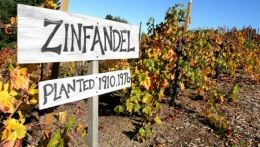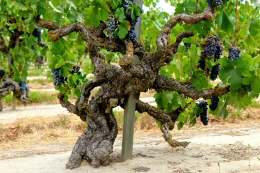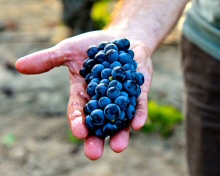|
 A lot of false information gets tossed out there regarding Zinfandel from those who know what they're talking about or those who believe they know what they are talking about. "It's originally from California, no it's from Italy… It's a different varietal from Italian Primitivo, no it's the same… White Zinfandel is made from a different varietal than red Zinfandel wines… It's only grown in California… It's not able to be grown in Monterey County… All of the old Zinfandel vines were pulled up long ago in California." A lot of false information gets tossed out there regarding Zinfandel from those who know what they're talking about or those who believe they know what they are talking about. "It's originally from California, no it's from Italy… It's a different varietal from Italian Primitivo, no it's the same… White Zinfandel is made from a different varietal than red Zinfandel wines… It's only grown in California… It's not able to be grown in Monterey County… All of the old Zinfandel vines were pulled up long ago in California."
Let's start with the grape's origin. The varietal has been grown in California since the mid-1800s and is one of the state's oldest varietals. But the varietal is not native to California It was brought during the Gold Rush days. It could have come from Italian immigrants, who knew the grape by a different name – Primitivo, named after the varietal's tendancy to ripen earlier. (Yup, they are the same, and the varietal had been grown in Italy's Apulia region - the "heel" of the country - for at least a hundred years prior to its introduction to the New World).
But the grape is not native to Italy either. The varietal can be traced to what is now Croatia, and is called either Crljenak Kastelanski or Tribidrag. And it could have been brought to California by Austrian immigrants. They were familiar with the varietal as the Austro-Hungarian empire encompassed Croatia. The Austrians created a new name for the varietal, and that name is similar in appearance and pronunciation to Zinfandel.
 Regardless of how it arrived in California, there is no doubt that once the varietal was here it found a new home in a big way. Some of the oldest vines in the state are Zinfandel planted in Amador, Lodi, and Napa. For a period in the 19th century, it's believed that Zinfandel was the most widely planted varietal in the state. Regardless of how it arrived in California, there is no doubt that once the varietal was here it found a new home in a big way. Some of the oldest vines in the state are Zinfandel planted in Amador, Lodi, and Napa. For a period in the 19th century, it's believed that Zinfandel was the most widely planted varietal in the state.
Zinfandel historically was used as a blending varietal. The grape was widely planted in large Central Valley vineyards and remains planted there to this day. Zinfandel continues to be used for mass production wines (in both red and pinkish form – see below) and is the third most widely planted varietal in the state after Chardonnay and Cabernet Sauvignon. This represents roughly 80% of the planted Zinfandel in the state, leaving the remaining 20% to be grown as higher quality Zinfandel varietal wines and blends. But, of course, we can't not address the wine that those of the baby boomer generation most associate with Zinfandel.
White Zinfandel – the pinkish form of Zinfandel wine – is in fact produced from the same grape and accounts for around 10 percent of wine sales in the United States. Even though White Zin wines are considered to be more varietal driven and less sweet than in the past, these wines will always be considered in the non-serious wine category. However, it's due to the popularity of these blush wines that some of the old Zinfandel vines outside of the Central Valley were saved and not ripped out to plant other varietals.
These days, US producers are making a full spectrum of wines with the Zinfandel grape, ranging from blushes, lighter reds, huge hearty reds, and port-style fortified wines. The varietal is grown around the country, but is most prominent in Californian vineyards. Places like Amador, Lodi, Paso Robles, Napa, and Sonoma all produce exceptional Zinfandel wines, with each growing area often exhibiting differing varietal and terroir characteristics. And, yes, it is very possible to grow Zinfandel and produce excellent wines from the varietal in Monterey County. Craftwork and Shale Canyon are both currently producing Zinfandels that will match up to any in the state.
Speaking of wine styles, there are a few common Zinfandel flavor profiles. Zinfandel wines from cooler growing areas tend to have more red berry flavors such as raspberries and strawberries, and warmer climate areas produce wines with pronounced blackberry, anise, and pepper aromas. Regardless of where produced, Zinfandel wines can be expected to be bold and full bodied wines. As the grapes have high sugar content, the wines will normally also have high alcohol content.
 Zinfandel grapes are not considered to be exceptional difficult to grow compared to other varietals. However, the thin-skinned grapes are prone to bunch rot and early ripening, both of which can present viticultural and winemaking challenges. Zinfandel grapes are not considered to be exceptional difficult to grow compared to other varietals. However, the thin-skinned grapes are prone to bunch rot and early ripening, both of which can present viticultural and winemaking challenges.
As for food pairing, big juicy jammy Zinfandel wines are perfect matches with barbeque and hearty meat meals. Barbeque ribs, beef, lamb, sausages…there's really nothing too bold to match with Zinfandel. Lighter style Zins can do well with poultry dishes, and both would pair well with pasta dishes. Zinfandel's wide pairing range also allows it to be paired with more difficult dishes to match with red wine such as chili, stews, or pizza.
Regardless of where the grape originated or the path it has taken to end up in our vineyards, on our shelves, and in our cellars…Zinfandel has proven itself to be a survivor and a varietal we are pleased to have planted in Monterey County.
|